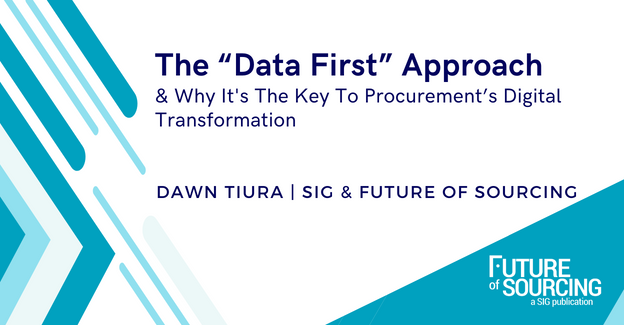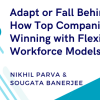Data — clean and accessible data is important.
Ask me to sum up in one sentence the recent Global Executive Summit session featuring the Founder and CEO of TealBook, Stephany Lapierre, and Nasdaq’s VP. Global Head of Procurement Jeff Wright, the "data is important" theme would pretty much cover it.
These industry leaders explained in their 40 minutes of excellent insight that "teams can leverage a supplier data platform to drive business outcomes and successfully achieve their digital procurement transformation.”
But here is the thing, you already know that data is important. It is the fuel that drives the engine of digital transformation and enterprise stability and success in a volatile world.
Anyone would be hard-pressed to argue with Jeff Wright’s assertion that “data is the foundation of your house (business),” driving “everything (you) do from (your) risk profile to (your) expense profile.”
Data, as he puts it, “is the heart and soul of what drives (your) firm.” As a result, everything you do needs to be “rooted in good, intelligent, and sustainable data.” Can I get an amen here?
The problem, however – and what makes this Global Executive Summit session different from any other on data- is learning to move beyond recognizing data's importance.
Once again, we all know why data – particularly supplier data- is essential. We don't seem to understand how to bridge the gap between this recognition and the tangible realization of data’s benefits on a real-world, real-time basis.
Understanding Supplier Data Challenges
Technology has come a long way from the early days of the personal computer and spreadsheet software – remember Visicalc. In other words, with the advent of powerful tools such as TealBook’s Supplier Data Platform (SDP), the capability to turn raw data into actionable knowledge is no longer limited by cumbersome technology.
Despite these amazing breakthroughs, a
2020 Supplier Information Study from TealBook (Severe Business Consequences Stem from Poor Supplier Data, Survey Shows) reported several eye-opening statistics, including:
- 93% of procurement and supply chain leaders experience the adverse effects of misinformation about their suppliers, with nearly half (47%) experiencing said negative effects regularly.
- On average, it takes organizations 21 days to validate and onboard suppliers, with 81% of executives indicating that despite the effort, they are only partially confident in their supplier data.
- Finally, 60% of the executives who reported that their supplier information was outdated indicated that it took them four days to update that information. While four days may not seem like a long time, these seemingly minor hiccups resulted in severely negative consequences, such as missed deadlines (51%), unhappy clients (42%) or even financial loss (40%).
Given the above findings, if technology is not the problem, why are companies still struggling to leverage their data to realize its full potential?
Between The Spreadsheets
To borrow a phrase used by
Susan Walsh when it comes to data capture, management, and utilization, we first need to get "between the spreadsheets.”
Based on a 2022
report, “67.4% of supply chain managers use Excel spreadsheets as a management tool.” I will revisit this supply chain manager's use of spreadsheets shortly.
While our research indicates that this 2022 number represents a notable drop from the 81% of spreadsheet users in 2010, it is still a sizeable percentage. If you think about it, a significant number of procurement leaders still manage their data using a “technology” with origins going as far back as 1979.
I could point to user comfort and familiarity with spreadsheet applications as compelling reasons for their continued use. However, two June 2022
parallel polls may shed some light on the matter.
The question, “why do procurement professionals continue to use spreadsheets,” was posed to two separate groups: CPOs and the rest of the procurement community. The reasoning behind the parallel polling was to see if there was a difference of opinion regarding spreadsheet usage between senior management and frontline procurement professionals.
If not surprisingly, the results were telling as 69% of CPOs and the procurement community at large picked “ease of use” and the ability to “share data in a common format” as the one-two reasons for using spreadsheets.
Even though using spreadsheets may seem more convenient, are they “really more efficient” than the new digital technology is an immediate question that comes to mind.
As the polls suggest, is the “C-Suite to procurement’s frontlines dogged loyalty to 1979 pc tech impeding the move to more efficient 2022 digital tech?”
Change From the Top
The August 2022 report “The State of Digital Adoption 2022 – 2023” highlights the consequences of the struggle organizations face to get employees to “use digital tools as they are intended and to their fullest extent.”
Besides overspending up to $32 million due to what the report refers to as the “uptake of digital technology,” 67% of leadership is still under “incredible pressure to accelerate digital transformation.”
In addition to using outdated change management programs to facilitate greater adoption of new technologies, there appears to be a lack of “visible” direction from the top. Based on the report’s findings, 70% of people within a company “could not identify exactly who is responsible for managing the adoption of new technologies in their organizations.”
The above findings suggest that change, which always begins at the top, must start with management eschewing their significant reliance on spreadsheets. In other words, lead by example, starting with a better understanding of user experience.
Now, I am not suggesting that we entirely do away with spreadsheets. Like the pencil and the calculator, there is still a place for this tool in everyday business.
However, given the amazing technology available now, spreadsheets should not be used as the primary platform to manage data. Put another way; it is time to put data first, which means embracing digital technology to realize its full potential as an industry game-changer.
Using the Tealbook – Nasdaq
session as a starting point is an excellent place to start.








